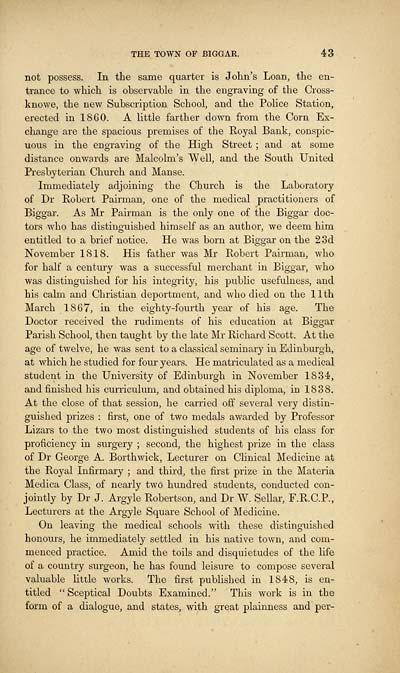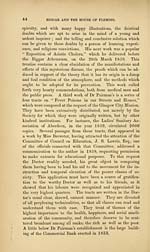Biggar and the House of Fleming
(65) Page 47
Download files
Complete book:
Individual page:
Thumbnail gallery: Grid view | List view

THE TOWN OF BIGGAR. 43
not possess. In the same quarter is John's Loan, the en-
trance to which is observable in the engraving of the Cross-
knowe, the new Subscription School, and the Police Station,
erected in 1860. A little farther down from the Corn Ex-
change are the spacious premises of the Royal Bank, conspic-
uous in the engraving of the High Street ; and at some
distance onwards are Malcolm's Well, and the South United
Presbyterian Church and Manse.
Immediately adjoining the Church is the Laboratory
of Dr Robert Pairman, one of the medical practitioners of
Biggar. As Mr Pairman is the only one of the Biggar doc-
tors who has distinguished himself as an author, we deem him
entitled to a brief notice. He was born at Biggar on the 23d
November 1818. His father was Mr Robert Pairman, who
for half a century was a successful merchant in Biggar, who
was distinguished for his integrity, his public usefulness, and
his calm and Christian deportment, and who died on the 11th
March 1867, in the eighty-fourth year of his age. The
Doctor received the rudiments of his education at Biggar
Parish School, then taught by the late Mr Richard Scott. At the
age of twelve, he was sent to a classical seminary in Edinburgh,
at which he studied for four years. He matriculated as a medical
student in the University of Edinburgh in November 1834,
and finished his curriculum, and obtained his diploma, in 1838.
At the close of that session, he carried off several very distin-
guished prizes : first, one of two medals awarded by Professor
Lizars to the two most distinguished students of his class for
proficiency in surgery ; second, the highest prize in the class
of Dr George A. Borthwick, Lecturer on Clinical Medicine at
the Royal Infirmary ; and third, the first prize in the Materia
Medica Class, of nearly two hundred students, conducted con-
jointly by Dr J. Argyle Robertson, and Dr W. Sellar, F.R.C.P.,
Lecturers at the Argyle Square School of Medicine.
On leaving the medical schools with these distinguished
honours, he immediately settled in his native town, and com-
menced practice. Amid the toils and disquietudes of the life
of a country surgeon, he has found leisure to compose several
valuable little works. The first published in 1848, is en-
titled " Sceptical Doubts Examined." This work is in the
form of a dialogue, and states, with great plainness and per-
not possess. In the same quarter is John's Loan, the en-
trance to which is observable in the engraving of the Cross-
knowe, the new Subscription School, and the Police Station,
erected in 1860. A little farther down from the Corn Ex-
change are the spacious premises of the Royal Bank, conspic-
uous in the engraving of the High Street ; and at some
distance onwards are Malcolm's Well, and the South United
Presbyterian Church and Manse.
Immediately adjoining the Church is the Laboratory
of Dr Robert Pairman, one of the medical practitioners of
Biggar. As Mr Pairman is the only one of the Biggar doc-
tors who has distinguished himself as an author, we deem him
entitled to a brief notice. He was born at Biggar on the 23d
November 1818. His father was Mr Robert Pairman, who
for half a century was a successful merchant in Biggar, who
was distinguished for his integrity, his public usefulness, and
his calm and Christian deportment, and who died on the 11th
March 1867, in the eighty-fourth year of his age. The
Doctor received the rudiments of his education at Biggar
Parish School, then taught by the late Mr Richard Scott. At the
age of twelve, he was sent to a classical seminary in Edinburgh,
at which he studied for four years. He matriculated as a medical
student in the University of Edinburgh in November 1834,
and finished his curriculum, and obtained his diploma, in 1838.
At the close of that session, he carried off several very distin-
guished prizes : first, one of two medals awarded by Professor
Lizars to the two most distinguished students of his class for
proficiency in surgery ; second, the highest prize in the class
of Dr George A. Borthwick, Lecturer on Clinical Medicine at
the Royal Infirmary ; and third, the first prize in the Materia
Medica Class, of nearly two hundred students, conducted con-
jointly by Dr J. Argyle Robertson, and Dr W. Sellar, F.R.C.P.,
Lecturers at the Argyle Square School of Medicine.
On leaving the medical schools with these distinguished
honours, he immediately settled in his native town, and com-
menced practice. Amid the toils and disquietudes of the life
of a country surgeon, he has found leisure to compose several
valuable little works. The first published in 1848, is en-
titled " Sceptical Doubts Examined." This work is in the
form of a dialogue, and states, with great plainness and per-
Set display mode to:
![]() Universal Viewer |
Universal Viewer | ![]() Mirador |
Large image | Transcription
Mirador |
Large image | Transcription
Images and transcriptions on this page, including medium image downloads, may be used under the Creative Commons Attribution 4.0 International Licence unless otherwise stated. ![]()
| Histories of Scottish families > Biggar and the House of Fleming > (65) Page 47 |
|---|
| Permanent URL | https://digital.nls.uk/94840062 |
|---|
| Description | A selection of almost 400 printed items relating to the history of Scottish families, mostly dating from the 19th and early 20th centuries. Includes memoirs, genealogies and clan histories, with a few produced by emigrant families. The earliest family history goes back to AD 916. |
|---|

